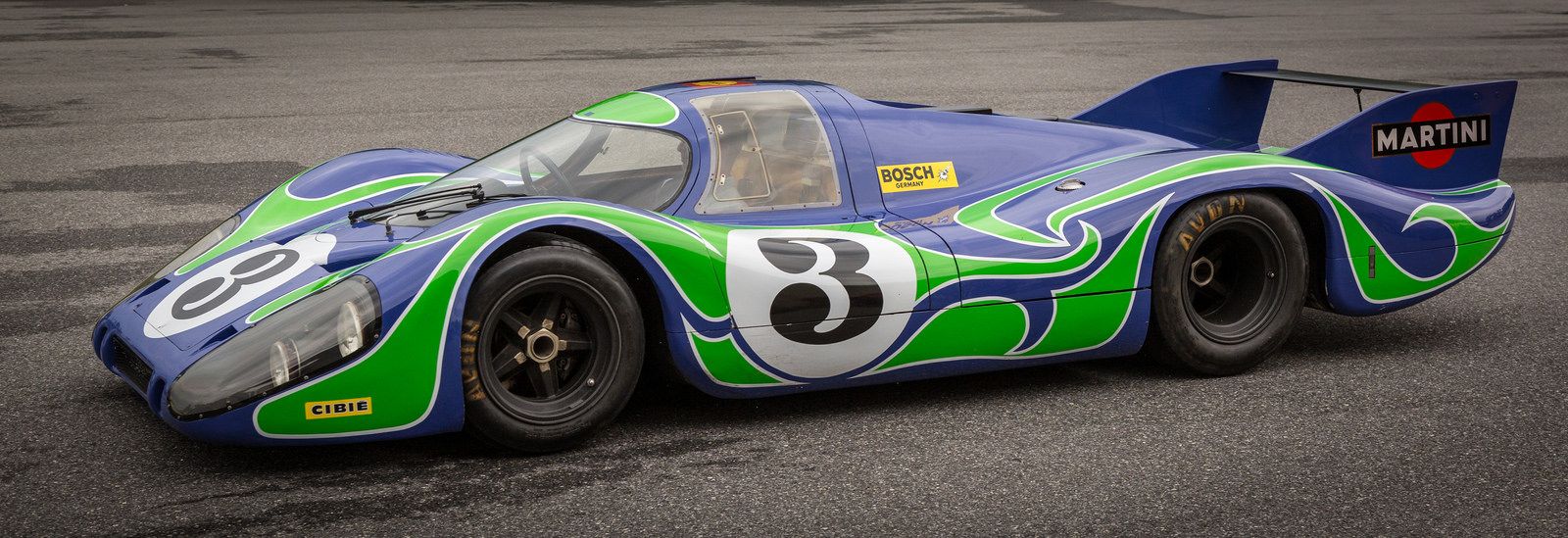1970 Porsche 917 LH

The descriptions of the Classic Cars in the Directory were partly generated or supplemented with the help of artificial intelligence (AI). The content may occasionally not always be entirely accurate or factually correct despite careful checking.
The Porsche 917 LH 1970 is an iconic race car that was developed for the Le Mans 24-hour endurance race. It debuted in that race in 1970, and its design was based on the Porsche 917K, which was developed for shorter races. The 917 LH was a longer and sleeker version that was specifically designed for the high-speed sections of the Le Mans track.
At the heart of the 917 LH is a 4.5-liter, 12-cylinder engine that produces a staggering 600 horsepower. The engine was air-cooled, and it had four valves per cylinder. It was designed to run on a fuel mixture of methanol, gasoline, and air, which allowed it to achieve high speeds while also being efficient.
The chassis of the 917 LH was made from aluminum and magnesium, which helped to keep it lightweight. The chassis was also designed to be very rigid, which helped to improve overall handling and stability. The suspension system used double wishbones at the front and rear, which allowed for a great deal of adjustability.
The aerodynamics of the 917 LH were also a major factor in its success on the track. The car's long tail and low-slung body helped to reduce drag and increase downforce. The front of the car was designed with a large lip spoiler that directed air over the car, further reducing drag.
The car's transmission was a five-speed manual, which was mounted transversely behind the engine. This design helped to distribute the weight of the car more evenly and provided better balance during high-speed cornering.
To help control the immense power generated by the engine, the 917 LH used large disc brakes all around. The brakes had four-piston calipers and were cooled by air ducts that routed air from the front of the car to the brakes.
In terms of performance, the 917 LH was an absolute beast on the track. It had a top speed of over 230 mph, and it could accelerate from 0 to 60 mph in just 2.3 seconds. Its performance was so impressive that it set a new lap record at Le Mans in 1970, which stood for over a decade.
Overall, the Porsche 917 LH 1970 was a masterpiece of engineering and design. Its technical details were carefully crafted to provide the best performance possible on the track, and it still remains one of the most iconic race cars of all time.
Milestones
- The Porsche 917 LH was first introduced in 1969 as part of Porsche's entry into the FIA's World Sportscar Championship. - The 1970 version of the Porsche 917 LH featured an extended tail and aerodynamic modifications for increased top speed. - The car was powered by a flat-12 engine capable of producing up to 600 horsepower. - In the 1970 24 Hours of Le Mans, the Porsche 917 LH driven by Hans Herrmann and Richard Attwood earned Porsche its first overall victory at the prestigious endurance race. - The victory was hard-fought and the car experienced technical issues throughout the race, ultimately winning by just a few seconds over the second place finisher. - The Porsche 917 LH went on to win several other races throughout the 1970 season, including the Spa 1000km and the Brands Hatch 1000km. - The 917 LH's success helped cement Porsche's dominance in endurance racing during the early 1970s. - The car has since become a legendary piece of Porsche's racing history and is still remembered as one of the most iconic and successful racecars ever created.Technical
- The Porsche 917 LH (long tail) was first introduced in 1970 as an evolution of the original 917K. - It featured an elongated body design, which improved the car's aerodynamic efficiency and top speed. - The chassis was made of aluminum honeycomb monocoque, which was both lightweight and strong. - The car was powered by a 4.9-liter air-cooled flat-12 engine that produced up to 600 horsepower. - The engine featured dual-overhead camshafts, four valves per cylinder, and a fuel injection system. - The Porsche 917 LH had a top speed of around 240 mph and could accelerate from 0 to 60 mph in just 2.5 seconds. - The car's suspension system consisted of double wishbones with coil springs and dampers at both the front and rear. - The brakes were ventilated discs with four-piston calipers, and the steering was rack-and-pinion. - The cockpit was designed with the driver's comfort and safety in mind, featuring a roll cage, bucket seat, and a 6-point harness. - The car was produced in limited numbers, with only five examples being built between 1970 and 1971.